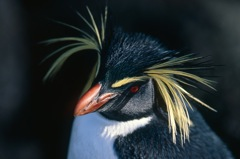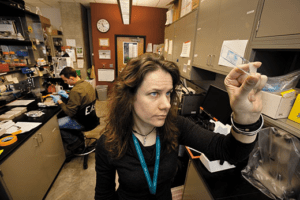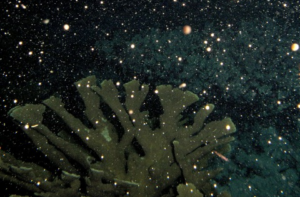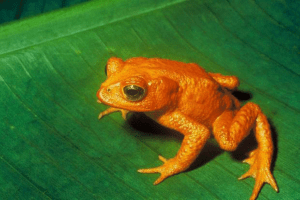
Alicia Patterson Report 4 – 2011 Fellowship
A version of this story appeared in the August 2012 issue of Scientific American.
The ashy storm-petrel, a tiny, dark-gray seabird, nests on 11 rocky, isolated islands in the Pacific Ocean off the coasts of California and Mexico. Weighing little more than a hefty greeting card and forced to contend with invasive rats, mice and cats, aggressive seagulls, oil spills and sea-level rise, it faces an outsize fight for survival. At last count, only 10,000 remained. Several other species of storm-petrels are similarly endangered.
Yet at least one conservation group has decided to ignore the petrel. In the winter of 2008 the Wildlife Conservation Society was focusing its far-flung efforts on a small number of animals. The society’s researchers had spent months analyzing thousands of declining bird and mammal species around the world and had chosen several hundred that could serve as cornerstones for the organization’s work. They then turned to people with decades of experience studying wildlife to further narrow the possibilities.
Dozens of these experts gathered in small conference rooms in New York City, southwestern Montana and Buenos Aires to make their choices. They judged each species for its importance to its ecosystem, its economic and cultural value, and its potential to serve as a conservation emblem. They voted on each animal publicly, holding up red, yellow or green cards. When significant disagreement occurred, the experts backed up their reasoning with citations, and the panels voted again. By the middle of the first day most panels had eliminated more than half the species from their lists.
At some point in the afternoon, however, in every meeting, the reality of the process would hit. As entire groups of species, including storm-petrels, were deemed valuable but not valuable enough, a scientist would quietly shut down, shoulders slumped and eyes glazed. “I’m just overwhelmed,” he or she might say. Panel members would encourage their colleague, reminding him or her that these choices were necessary and that the science behind them was solid. John Fraser, a conservation psychologist who moderated the panels, would suggest a coffee break. “I’d say, ‘I’m sorry, but we have to stop. This is a very important part of the process,’” he remembers. “It was important to recognize the enormity of what we were doing—that we were confronting loss on a huge scale.”
The experts knew that all conservation groups and government agencies were coping with similar choices in tacit ways, but the Wildlife Conservation Society process made those decisions more explicit and more painful. As budgets shrink, environmental stresses grow, and politicians and regulators increasingly favor helping the economy over helping the planet, many scientists have come to acknowledge the need for triage. It is time, they say, to hold up their cards.
The concept of conservation triage is based loosely on medical triage, a decision-making system used by battlefield medics since the Napoleonic Wars. Medical triage has several variations, but all of them involve sorting patients for treatment in difficult situations where time, expertise, supplies, or all three are scarce. The decisions are agonizing but are considered essential for the greater good.
In 1973, however, when the U.S. Congress passed the Endangered Species Act, the mood was not one of scarcity but of generosity. The act, still considered the most powerful environmental law in the world, stipulated eligibility for protection for all nonpest species, from bald eagles to beetles. Later court decisions confirmed its broad reach.
In their book Noah’s Choice, journalist Charles C. Mann and economist Mark L. Plummer describe the act’s reasoning as the Noah Principle: all species are fundamentally equal, and everything can and should be saved, regardless of its importance to humans.
Trouble arose in the late 1980s, when proposed endangered-species listings of the northern spotted owl and some salmon varieties threatened the economic interests of powerful timber and fishing industries, setting off a series of political and legal attempts to weaken the law. Environmentalists fought off the attacks, but the bitter struggle made many supporters suspicious of any proposed changes to the law, even those intended to increase its effectiveness. In particular, proponents feared that any overt attempt to prioritize endangered species—to apply the general principle of triage—would only strengthen opponents’ efforts to try to cut species from the list. If such decisions had to happen, better that they be made quietly, out of political reach.
“The environmental community was always unwilling to talk about triage,” says Holly Doremus, a law professor at the University of California, Berkeley. “Even though they knew it was going on, they were unwilling to talk about it.”
Today triage is one of the most provocative ideas in conservation. To many, it invokes not only political threats to laws such as the Endangered Species Act but an abandonment of the moral responsibility for nature implied in the Noah Principle. “Triage is a four-letter word,” conservation biologist Stuart Pimm recently told Slate’s Green Lantern blog. “And I know how to count.”
Conservationists who are pushing for explicit triage say they are bringing more systematic thinking and transparency to practices that have been carried out implicitly for a long time. “The way we’re doing it right now in the United States is the worst of all possible choices,” says Tim Male, a vice president at Defenders of Wildlife. “It essentially reflects completely ad hoc prioritization.” Politically controversial species attract more funding, he says, as do species in heavily studied places: “We live in a world of unconscious triage.”
In recent years researchers have proposed several ways to make triage decisions, with the aim of providing maximum benefit for nature as a whole. Some scientists argue for weighting species according to their role in the ecosystem, an approach we might call “function first.” Threatened species with a unique job, they say, or “umbrella” species whose own survival ensures the survival of many others, should be protected before those with a so-called redundant role. One example is the campaign to protect the Rocky Mountains’ high-elevation whitebark pines, trees stressed by warming temperatures and associated beetle outbreaks. Because high-fat whitebark pine nuts are an important food source for grizzly bears in the fall and spring, many conservation groups view the pine as a priority species.
The advantage of this function-first approach is that it focuses on specific ecological roles rather than raw numbers of species, giving conservationists a better chance at protecting functioning ecosystems. The approach, however, is useful only in well-understood systems, and the number of those is small. An exclusively function-first analysis would almost certainly leave many ecologically important species behind.
As an alternative, the EDGE (Evolutionarily Distinct and Globally Endangered) of Existence program run by the Zoological Society of London argues for prioritizing species at the genomic level, an approach we might call “evolution first.” Rather than focusing on well-known species with many near relatives, the EDGE program favors the most genetically unusual threatened species. Examples include the two-humped Bactrian camel; the long-beaked echidna, a short, spiny mammal that lays eggs; and the Chinese giant salamander, which can grow to six feet in length.
The evolution-first approach emphasizes the preservation of genetic diversity, which can help all the world’s species survive and adapt in fast-changing environmental conditions by providing a robust gene pool. But as University of Washington ecologist Martha Groom points out, exclusive use of the approach could miss broader threats that affect entire taxa, leaving groups of species vulnerable to wholesale extinction. “What if a whole branch of the evolutionary tree is endangered?” she asks. “What do we do then?”
Of course, species are valuable for many different reasons. Some play a vital role in the ecosystem, some have unique genes, some provide extensive services to humans. No single criterion can capture all these qualities. The Wildlife Conservation Society combined different triage approaches in its analyses: it gave priority to threatened species that have larger body size and wider geographic range, reasoning that protection of these creatures would likely benefit many other plants and animals. It also gave higher rankings to species with greater genetic distinctiveness. The expert panels then considered more subjective qualities, such as cultural importance and charisma, which, like it or not, are important to fund-raising.
Groom, who helped to lead the society’s analysis, says it opted for the combined approach because much of the information she and her colleagues needed was unknown or unquantifiable. “There’s an awful lot of uncertainty and ignorance about all species,” she says. But with a combination of available data and expert opinions, the analysis identified a small group of “global priority” species that the organization can focus on.
Given the importance of protecting not simply individual animals but also the relations among them, some researchers say that triage approaches should select among ecosystems instead of species. In the late 1980s British environmentalist Norman Meyers proposed that his global colleagues try to protect the maximum number of species by focusing on land areas that were full of plants found nowhere else on the planet and that were also under pressing environmental threats.
Meyers called such places hotspots. He and his partners at Conservation International eventually identified 25 hotspots worldwide, from coastal California to Madagascar, that they thought should top priority lists. In a sense, the approach combines the function-first and evolution-first processes: it protects ecological relations by focusing on entire ecosystems, and it protects genetic diversity by prioritizing endemic species. The idea caught on and influences decisions by many philanthropists, environmental organizations and governments today.
Nevertheless, in recent years researchers have criticized hotspots for oversimplifying a global problem and for giving short shrift to human needs. “It was brilliant for its time,” says Hugh Possingham of the University of Queensland in Australia. “But it used just two criteria.”
In an effort to refine the concept, Possingham and his colleagues developed Marxan, a software program that is now in wide use. It aims to maximize the effectiveness of conservation reserves by considering not only the presence of endemic species and the level of conservation threats but also factors such as the cost of protection and “complementarity”— the contribution of each new reserve to existing biodiversity protections. Mangrove forests, for instance, are not particularly rich in species and might never be selected by a traditional hotspot analysis; Possingham’s program, however, might recommend protection of mangrove forests in an area where representative swaths of other, more diverse forest types had already been preserved, resulting in a higher total number of species protected.
Protected areas and parks, however, can be difficult to establish and police, and because climate change is already shifting species ranges, static boundaries may not offer the best long-term protection for some species. In response, Possingham has created a resource-
allocation process that goes well beyond the selection of hotspots, allowing decision makers to weigh costs, benefits and the likelihood of success as they decide among different conservation tactics. “You do actions—you don’t do species,” Possingham says. “All prioritizations should be about actions, not least because in many cases actions help multiple species.”
The New Zealand Department of Conservation has used the resource-allocation process to analyze protection strategies for about 710 declining native species. It concluded that by focusing on the actions that were cheapest and most likely to succeed, it could save roughly half again as many plants and animals from extinction with the same amount of money. Although some scientists worry that the process places too much emphasis on preserving sheer numbers of threatened species and too little on preserving ecosystem function, resource-allocation analysis is now under way in Australia, and Possingham has spoken with U.S. Fish and Wildlife Service officials about the process.
“People think triage is about abandoning species or admitting defeat,” says Madeleine Bottrill of Conservation International, who is a colleague of Possingham. To the contrary, she argues: by quantifying the costs and payoffs of particular actions, the trade-offs become explicit. Agencies and organizations can identify what is being saved, what is being lost and what could be saved with a bigger budget, giving them a much stronger case for more funding.
It is possible that the very act of setting priorities more overtly could inspire societies to spend more money on conservation efforts. Defenders of Wildlife’s Male says prioritization schemes, far from exposing nature to political risks, offer practical and political advantages. “If we focus more effort on the things we know how to help, we’re going to produce more successes,” he says. “More successes are a really compelling argument — not just to politicians but to ordinary people — for why [conservation
programs] should continue.”
Trailing behind such successes, however, are undeniable losses, and true triage must acknowledge them. “We’re very good as humans, aren’t we, at justifying any amount of work on anything based on undeclared values,” says Richard Maloney of the New Zealand Department of Conservation. “We’re not very good at saying, ‘Because I’m working on this species, I’m not going to fund or work on these seven or eight species, and they’re going to go extinct.’” And yet Maloney himself is reluctant to name the species likely to lose out in his agency’s resource-allocation analysis. Rockhopper penguins — whose vital supply of krill has declined because of shrinking sea ice driven by climate change — fall to the bottom of the department’s list because of the costly, long-shot measures needed to protect them. Yet the species’ low priority, Maloney argues, should be seen not as a death sentence but as a call to action by other groups.
Sooner or later, though, a vulnerable species or habitat — the rockhopper penguin, the whitebark pine ecosystem — will require measures too expensive for any government or group to shoulder. What then? Do societies continue to pour money into a doomed cause or allow a species to die out, one by one, in plain sight? Even though the conversation about triage has come a long way, many conservationists remain uncomfortable taking responsibility for the final, fateful decisions that triage requires.
The central difficulty is that, just as with battlefield triage, the line between opportunity and lost cause is almost never clear. In the 1980s, when the population of California condors stood at just 22, even some environmentalists argued that the species should be permitted to “die with dignity.” Yet others made an evolution-first argument, calling for heroic measures to save the rare Pleistocene relic. With heavy investments of money, time and expertise, condors were bred in captivity and eventually returned to the wild, where 217 fly today, still endangered but very much alive.
“We can prevent extinction; we’ve demonstrated that,” says John Nagle, a law professor at the University of Notre Dame who has written extensively about environmental issues. But “knowing that an extinction was something we could have stopped and chose not to — I think that’s where people kind of gulp and don’t want to go down that road,” he adds.
Similarly, by creating what prominent restoration ecologist Richard Hobbs calls a “too-hard basket” for species that would cost too much to save, a triage system could allow societies to prematurely jettison tough cases, choosing short-term economic rewards over long-term conservation goals. The Endangered Species Act itself has one provision for such a too-hard basket — it allows for a panel of experts that can, in unusual circumstances, permit a federal agency to violate the act’s protections. But the so-called God Squad is deliberately difficult to convene and has so far made only one meaningful exemption to the act: letting the Forest Service approve some timber sales in habitats of the struggling northern spotted owl.
As climate change, population expansion and other global pressures on biodiversity continue, however, more and more species are likely to require heroic measures for survival. Prioritizing species by ecological function, evolutionary history or other criteria will help shape conservation strategies, but for the greater good of many other species, societies will almost certainly have to consciously forgo some of the most expensive and least promising rescue efforts.
In the U.S., legal scholars have suggested ways of reforming the Endangered Species Act to reckon with this reality — to help the law bend instead of break under political pressure. Yet Nagle says that the essence of the law, the Noah Principle, remains acutely relevant. Given the temptations that accompany triage, he says, the exhortation to save all species remains a worthy, and perhaps even necessary, goal. Just as a battlefield medic works unstintingly to save lives, even while knowing that he or she cannot save them all, societies should still aspire to the Noah Principle—and stuff the ark to the brim.
© 2011 Michelle Nijhuis



